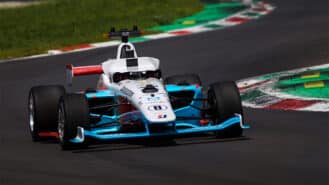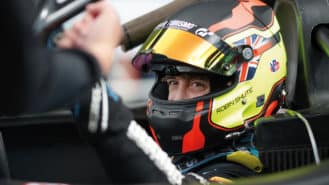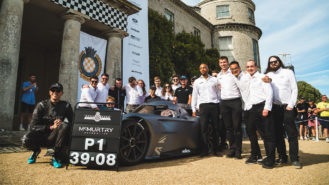
Driverless IndyCar to tackle Hillclimb at 2024 Goodwood Festival of Speed
A driverless car from the Indy Autonomous Challenge will take on a "special Hillclimb event" over the 2024 Goodwood Festival of Speed weekend
How the 1987 Volkswagen Twin Golf and driver Jochi Kleint came close to giving Röhrl a run for his money
Walter Röhrl’s 1987 victory at Pikes Peak in the Sport Quattro S1 E2 has gone down in legend as a last hurrah for the Group B monster and an iconic achievement Audi still trades off to this day.
Glory for Peugeot followed, first with Ari Vatanen and more recently with Sébastien Loeb. Now Volkswagen fancies its moment in the clouds at Pikes Peak’s 4302-metre summit, courtesy of three-time winner (and factory Porsche ace) Romain Dumas and an all-new electric prototype called the I.D. R Pikes Peak.
The car was unveiled this week at Dumas’ home circuit in southern France alongside VW’s previous contender, the near-forgotten Twin Golf that came so close to giving Röhrl a proper run for its money back in 1987. Talk of unfinished business and a score to be settled adds spice to Volkswagen’s 2018 entry but for the Golf’s driver, Jochi Kleint, it’s a chance to belatedly celebrate a brave and eccentric attempt to take on the might of Audi.
A fit-looking 70 years old, Kleint joined Dumas for the unveiling of the I.D. R but was also in attendance at a Volkswagen GTi Performance Days event the previous week, which is where we caught up with him and his incredible car.
With its bodywork in place, you could almost mistake the Twin Golf for a rally-prepared Mk2 GTi. Then the whole rear of the car lifts to reveal a longitudinally mounted 326hp 1.8-litre turbocharged Golf GTi 16V engine between the rear wheels and you realise it’s something a bit special. Just how special becomes apparent when the entire front end of the car is unclipped and another, identical, engine is revealed.
Audi’s achievement at Pikes Peak isn’t to be belittled. But with sights on a third consecutive win, Röhrl on the payroll and an otherwise redundant Sport Quattro capable of realising its full potential in the Unlimited class it was odds-on. Volkswagen’s underdog effort is the more astonishing for the eccentric technical solution chosen to take the race to its in-house rivals. In Kleint it had a driver who knew the car, the hill and – most importantly – his rival.
“Walter have known each other for years,” he recalls, Röhrl’s early rally career taking place in a Capri prepared by the Kleint family’s Hamburg-based garage. Throughout the 1970s they competed alongside – and against – each other in the German national championships before Kleint’s Opel contract locked him into a rear-wheel drive Ascona just as rallying went four-wheel drive.
In 1987 he had his chance to get one back on his superstar friend, and in the Twin Golf he was confident he had the car to do it.
“It was not an easy car to drive,” he admits. “But it was powerful and because we had the two engines it had perfect 50/50 weight balance. The Audi had the aero from Group B and the Quattro needed it to be balanced but with the Golf we wanted to win in a standard looking car!”
Did he really stand a chance though? “Yes!” he says.
“We didn’t have downforce, we had upforce! But the car was very powerful – more than 600hp – and so long as you were smooth it was very fast. I had to drive very carefully and not get it sideways too much because then it lost speed. You could not do anything sudden with it but I had learned how to drive it by that point.”
Kleint and previous versions of the Twin Golf had also competed in 1985 and 1986 but the 1987 version was its best chance of breaking Audi’s dominant run. Sitting at the wheel he points out some of the eccentricities, such as the duplicated instruments, petrol pumps and start buttons. There’s only one accelerator pedal for the respective throttles and a single H-pattern shifter for the linked transmissions, the challenge for Kleint being to balance the two mechanically independent powertrains to best effect, there being no prop shaft connecting them.
The idea of a grey, near stock looking Golf beating a Sport Quattro in all its Group B pomp is a tantalising prospect, Kleint enjoying the mischief as much as he rues what might have been. Because just a couple of corners from the summit the Golf broke and his one shot at beating his old friend was over, the failure all the more galling for the fact early splits had him leading. Thirty years on it clearly still riles him and he’s keen to point out exactly which of the rose joints on the rear suspension let him down after a grease port cracked and left the wheel dangling. “A part that costs maybe five euros, that’s all it was,” he shrugs.
Alongside the I.D. R Pikes Peak electric car that gulf in technology is frankly shocking. Whether by accident or design there are parallels though, the electric car likewise having a separate engine for each axle, 600-odd horsepower and a kerb weight of a little over a tonne. Black boxes to manage the power output of each motor and wild aero will help Dumas in his job, likewise the fact the track is now paved the whole way up.
Not to say he’s got it easy, the stated goal to at least beat Rhys Millen’s 2016 electric car record, and hopefully match his achievement of the previous year, and take the outright win in an EV. But he’s also got a duty to finish the job started by Kleint, his team and the crazy twin-engined car they so nearly took to glory three decades ago. It’s been a long time coming, but, if he pulls it off, you get the impression Kleint will finally consider honour satisfied.

A driverless car from the Indy Autonomous Challenge will take on a "special Hillclimb event" over the 2024 Goodwood Festival of Speed weekend

Robin Shute, a man now synonymous with the legendary Pikes Peak hill climb challenge, is going for the all-time record in his own – faster than ever – machine

Britain’s Robin Shute completed his hat-trick at the Pikes Peak International Hillclimb in Colorado, USA on Sunday. The California-based expat, who hails originally from Norfolk, won for the third time…

Max Chilton and the stunning McMurtry Spéirling fan car rocketed into the history books at Goodwood – he explains how they did it